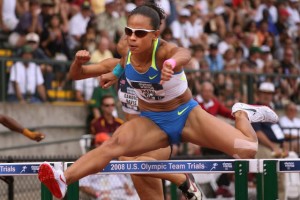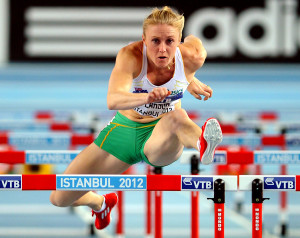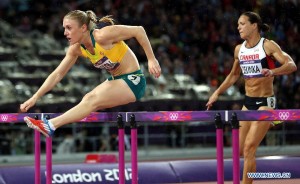Bent Leg vs. Straight Leg (as it applies to women)
When addressing the bent leg vs. straight leg question in regards to the women’s hurdles, it’s a much simpler discussion than when talking about the men’s race. Simply put, because the hurdles are so comparatively low in relation to the height of the average athlete, there is no reason for a female hurdler to lead with a straight leg. By raising their knee above the bar when attacking the hurdle at take-off, women hurdlers can sprint over each hurdle with very little adjustment to their center of mass.
[am4show not_have=’g5;’]
[/am4show][am4guest]
[/am4guest][am4show have=’g5;’]
It seems to me that many women have figured out that straightening the lead leg and then snapping it down is inefficient, which is why we see so many women 100 meter hurdlers running blazing times these days. In previous eras, you saw many female hurdlers achieve a high level of success with a straight leg lead. Gail Devers comes to mind, as does Ginnie Powell, and even Susanna Kallur had a very horizontal angle over the hurdle.
It seems to me that Sally Pearson is the one who deserves most of the credit for changing all of that. Pearson has been to the women’s race what Liu Xiang was to the men’s race – the model of technical excellence whose standards the rest of the world had to rise up to or else be left behind.
Before I go further into breaking down the aspects of Pearson’s technique, let me first go ahead and point out the major issue I have with the straight leg lead for women: it flattens out the trail leg. In the men’s race, the argument can be made that flattening out the trail leg can be a good thing, as it prevents the trail leg from hitting the hurdle. For me, even in the men’s race, I’d prefer a trail leg that rotates and cycles. The flattening out puts a lot of strain on the groin, and increases the distance the leg must travel to get to the front.
The photo below of Joanna Hayes serves as a good example of what the straight leg lead looks like on a female hurdler.
In the photo above, it is evident that the straightening of the lead leg with the knee locked is causing the trail leg to flatten out. As a result, she will have to put more effort into driving the trail leg knee up into her chest as she descends off the hurdle. Of course, in the women’s race, athletes can get away with a trail leg that drops, whereas the men will lose too much balance and therefore too much speed.
But now let’s take a look at Pearson. Because if you want to see how a lead leg that cycles looks, Pearson is the standard bearer. Again, as I said in the men’s article, I don’t like the term “bent leg” because the leg doesn’t stay bent; it straightens during descent off the hurdle as opposed to straightening out horizontally on top of the hurdle. Hence, the female hurdlers can run what I would describe as a downhill race much more easily than the men can.
The photo above shows Pearson taking off into the obstacle. The knee rises above the bar, thereby making the hurdle small, making her tall, putting her in a position to continue cycling. With such knee height, there is no need to kick, no need to rely on the foreleg to cover the distance. For Sally, it’s not about the hurdle, it’s about running. Her hips are pushing forward, so her center of mass is not rising hardly at all. And her push off the back leg, coupled with the high knee drive, makes her taller.
The above photo features Pearson attacking the hurdle, right before her heel crosses the crossbar. Here, the knee of the lead leg is slightly bent. This position is what has inspired the term “bent leg lead,” if you will. What I would like to emphasize here is that the bent lead leg is a cycling lead leg. Also, notice how the bent lead leg enables the trail leg to pull through at a tighter angle. You’re not seeing her trail leg flattening out. You’re seeing the groin open, but the knee of the trail leg is driving to the front. If her lead leg knee had locked into a straight position at this point, her trail leg would be much flatter. There’d be no cycling; instead there’d be two separate motions – a kick, then a snap.
The above photo shows Pearson on top of the hurdle, with her lead leg foot and calf slightly past the crossbar. Here, the lead leg is cycling back to the ground in one continuous, fluid motion. The knee is still slightly bent, but beginning to extend. The trail leg knee is driving to the front, with the heel directly under the hamstring. This is really, really good hurdling technique.
Finally, the above photo shows Pearson during descent. The underside of the knee has passed the crossbar, and her hamstring is directly above the bar. Now, and not until now, her lead leg straightens. The leg will continue to cycle under her hip (as opposed to snapping down), allowing her to seamlessly transition back into sprinting on the ground. So, the hurdle action basically serves as a fourth stride, as opposed to a separate, distinctive action from the other three strides prior to the hurdle and leading up to the next one.
To me, Pearson’s cyclical lead leg that stays bent on top of the hurdle before straightening during descent serves as the model that all female hurdlers should strive for. Much more so than the men, the women can cycle if they choose to; they don’t need to add any extra power moves or funky arm motions. If they think in terms of cycling their legs over the hurdles the same as they do between the hurdles, they can achieve a high level of efficiency and thereby maximize their flat sprinting speed.
[/am4show]





